Comprehensive Marketing Analysis: Strategies and Development Report
VerifiedAdded on 2022/10/14
|9
|2314
|21
Report
AI Summary
This report provides a comprehensive overview of marketing principles and strategies. It begins by defining marketing and the 7 Ps of the marketing mix, detailing how these elements contribute to a successful marketing strategy. The report then explores how businesses can leverage marketing to maintain competitiveness, including the use of SWOT analysis to identify strengths, weaknesses, opportunities, and threats. The Ansoff growth matrix is explained, with a focus on market development and diversification as key strategies for organizational growth. Finally, the report discusses how companies can enhance their performance and development through the effective implementation of digital marketing techniques such as social media marketing, affiliate marketing, and content marketing. The report concludes by summarizing the key components of the marketing mix and emphasizing the importance of strategic decision-making in achieving business objectives.
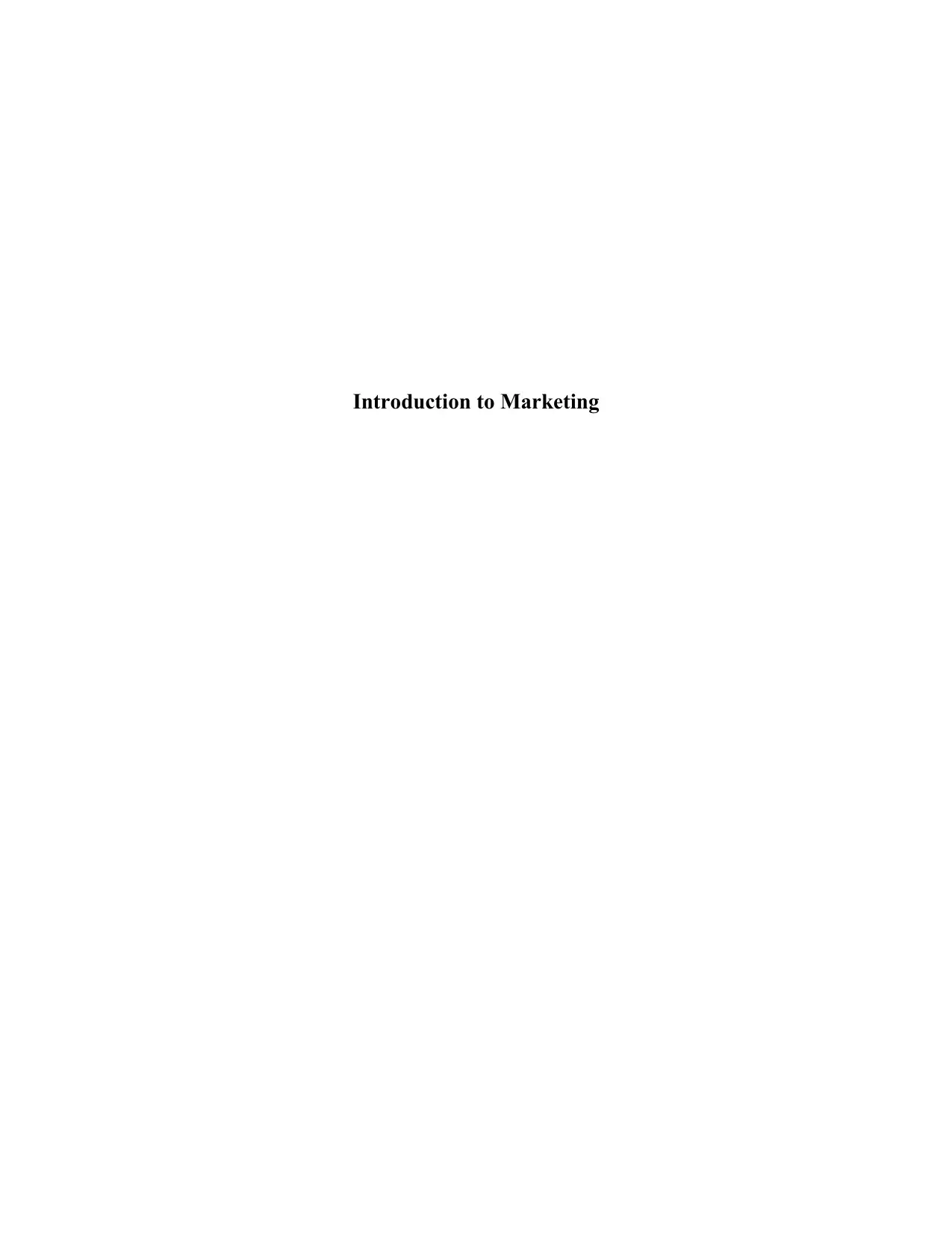
Introduction to Marketing
Paraphrase This Document
Need a fresh take? Get an instant paraphrase of this document with our AI Paraphraser
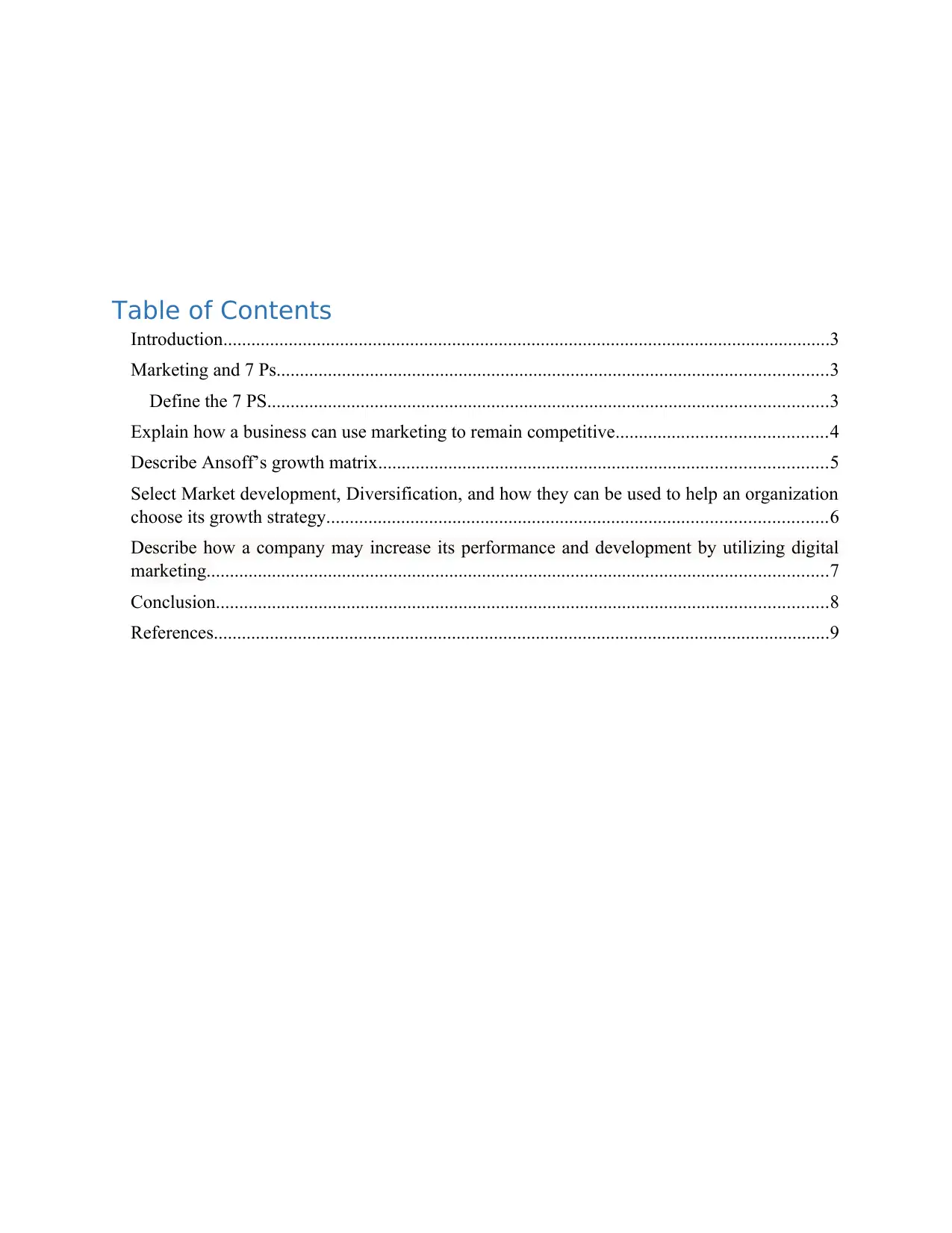
Table of Contents
Introduction..................................................................................................................................3
Marketing and 7 Ps......................................................................................................................3
Define the 7 PS........................................................................................................................3
Explain how a business can use marketing to remain competitive.............................................4
Describe Ansoff’s growth matrix................................................................................................5
Select Market development, Diversification, and how they can be used to help an organization
choose its growth strategy...........................................................................................................6
Describe how a company may increase its performance and development by utilizing digital
marketing.....................................................................................................................................7
Conclusion...................................................................................................................................8
References....................................................................................................................................9
Introduction..................................................................................................................................3
Marketing and 7 Ps......................................................................................................................3
Define the 7 PS........................................................................................................................3
Explain how a business can use marketing to remain competitive.............................................4
Describe Ansoff’s growth matrix................................................................................................5
Select Market development, Diversification, and how they can be used to help an organization
choose its growth strategy...........................................................................................................6
Describe how a company may increase its performance and development by utilizing digital
marketing.....................................................................................................................................7
Conclusion...................................................................................................................................8
References....................................................................................................................................9
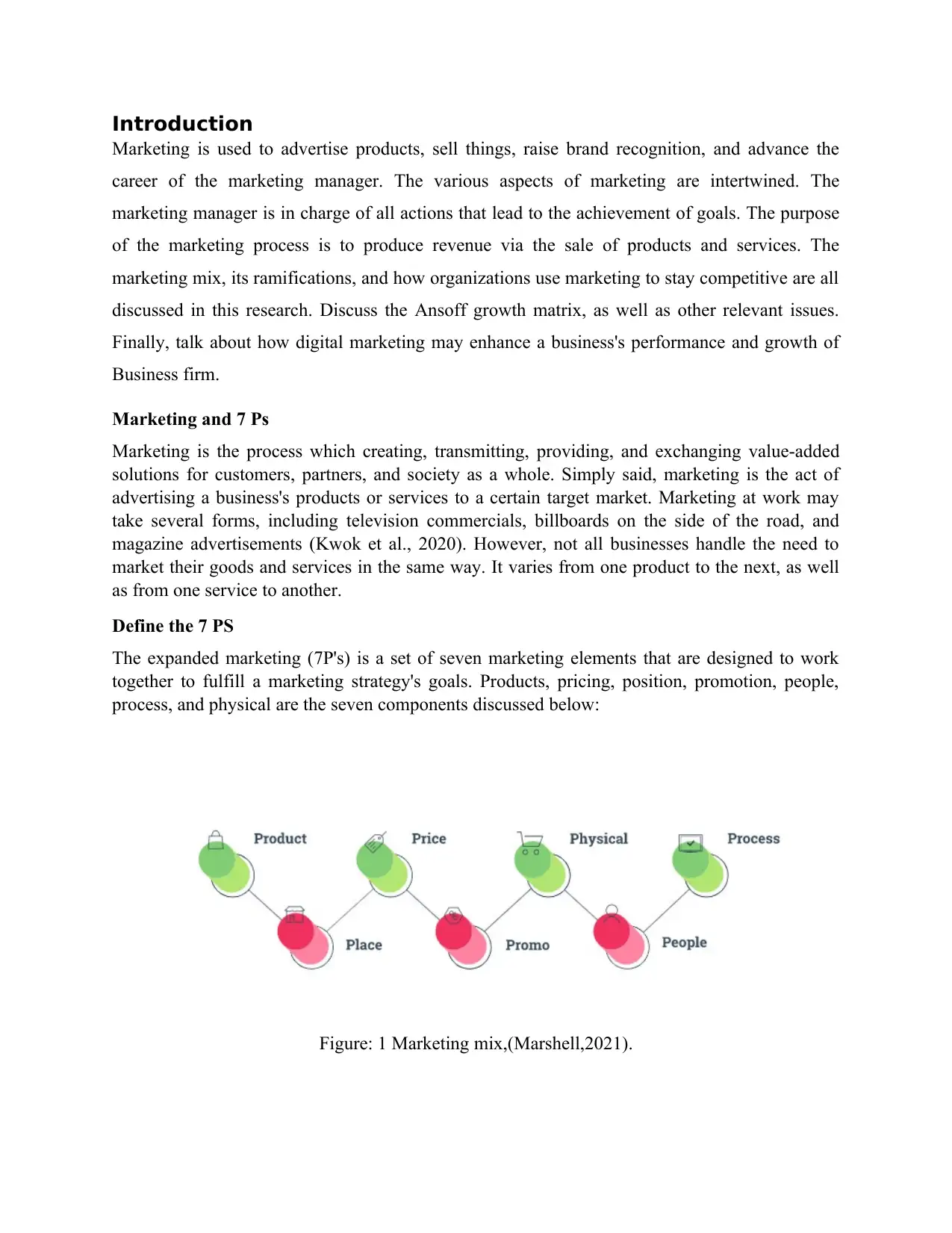
Introduction
Marketing is used to advertise products, sell things, raise brand recognition, and advance the
career of the marketing manager. The various aspects of marketing are intertwined. The
marketing manager is in charge of all actions that lead to the achievement of goals. The purpose
of the marketing process is to produce revenue via the sale of products and services. The
marketing mix, its ramifications, and how organizations use marketing to stay competitive are all
discussed in this research. Discuss the Ansoff growth matrix, as well as other relevant issues.
Finally, talk about how digital marketing may enhance a business's performance and growth of
Business firm.
Marketing and 7 Ps
Marketing is the process which creating, transmitting, providing, and exchanging value-added
solutions for customers, partners, and society as a whole. Simply said, marketing is the act of
advertising a business's products or services to a certain target market. Marketing at work may
take several forms, including television commercials, billboards on the side of the road, and
magazine advertisements (Kwok et al., 2020). However, not all businesses handle the need to
market their goods and services in the same way. It varies from one product to the next, as well
as from one service to another.
Define the 7 PS
The expanded marketing (7P's) is a set of seven marketing elements that are designed to work
together to fulfill a marketing strategy's goals. Products, pricing, position, promotion, people,
process, and physical are the seven components discussed below:
Figure: 1 Marketing mix,(Marshell,2021).
Marketing is used to advertise products, sell things, raise brand recognition, and advance the
career of the marketing manager. The various aspects of marketing are intertwined. The
marketing manager is in charge of all actions that lead to the achievement of goals. The purpose
of the marketing process is to produce revenue via the sale of products and services. The
marketing mix, its ramifications, and how organizations use marketing to stay competitive are all
discussed in this research. Discuss the Ansoff growth matrix, as well as other relevant issues.
Finally, talk about how digital marketing may enhance a business's performance and growth of
Business firm.
Marketing and 7 Ps
Marketing is the process which creating, transmitting, providing, and exchanging value-added
solutions for customers, partners, and society as a whole. Simply said, marketing is the act of
advertising a business's products or services to a certain target market. Marketing at work may
take several forms, including television commercials, billboards on the side of the road, and
magazine advertisements (Kwok et al., 2020). However, not all businesses handle the need to
market their goods and services in the same way. It varies from one product to the next, as well
as from one service to another.
Define the 7 PS
The expanded marketing (7P's) is a set of seven marketing elements that are designed to work
together to fulfill a marketing strategy's goals. Products, pricing, position, promotion, people,
process, and physical are the seven components discussed below:
Figure: 1 Marketing mix,(Marshell,2021).
⊘ This is a preview!⊘
Do you want full access?
Subscribe today to unlock all pages.

Trusted by 1+ million students worldwide
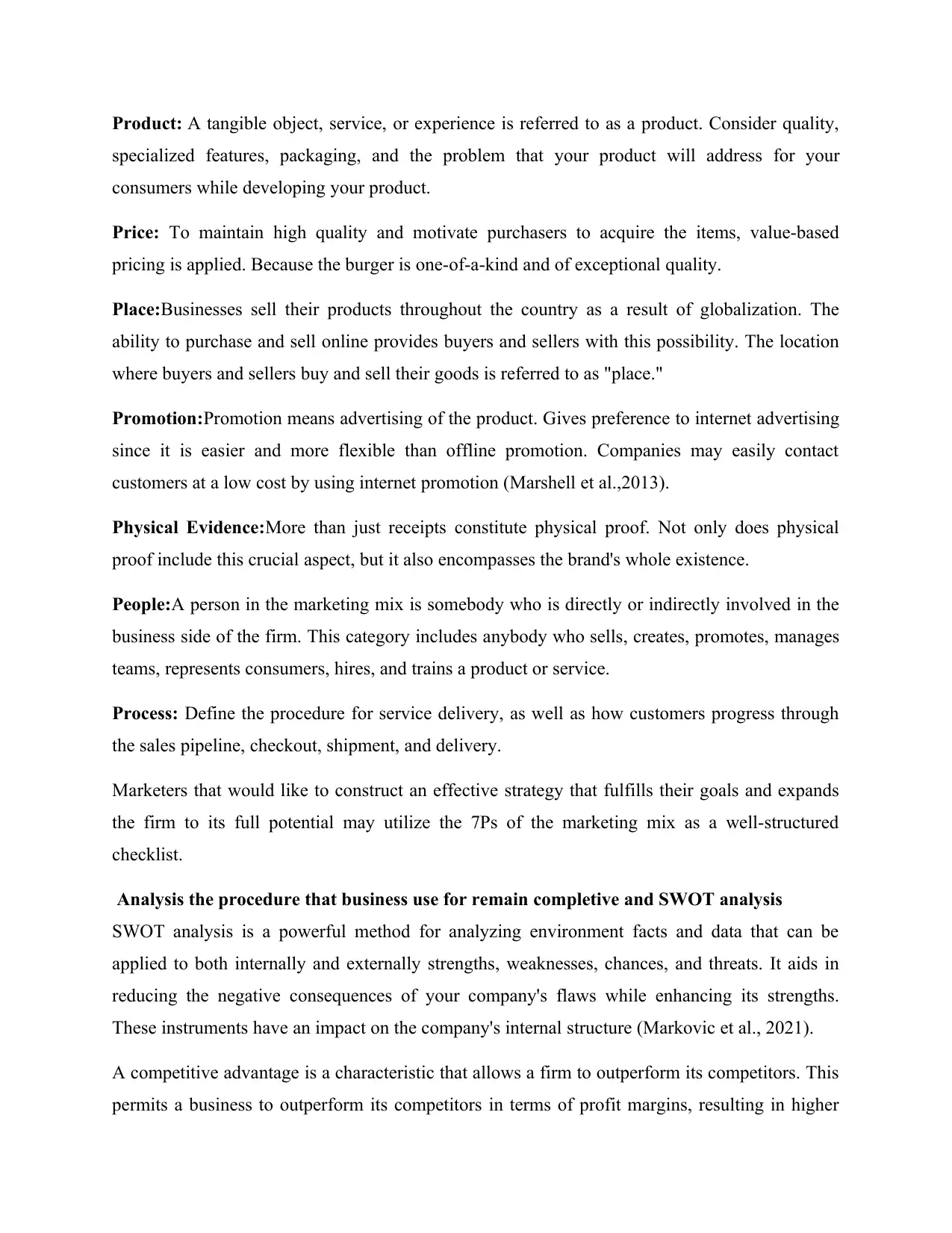
Product: A tangible object, service, or experience is referred to as a product. Consider quality,
specialized features, packaging, and the problem that your product will address for your
consumers while developing your product.
Price: To maintain high quality and motivate purchasers to acquire the items, value-based
pricing is applied. Because the burger is one-of-a-kind and of exceptional quality.
Place:Businesses sell their products throughout the country as a result of globalization. The
ability to purchase and sell online provides buyers and sellers with this possibility. The location
where buyers and sellers buy and sell their goods is referred to as "place."
Promotion:Promotion means advertising of the product. Gives preference to internet advertising
since it is easier and more flexible than offline promotion. Companies may easily contact
customers at a low cost by using internet promotion (Marshell et al.,2013).
Physical Evidence:More than just receipts constitute physical proof. Not only does physical
proof include this crucial aspect, but it also encompasses the brand's whole existence.
People:A person in the marketing mix is somebody who is directly or indirectly involved in the
business side of the firm. This category includes anybody who sells, creates, promotes, manages
teams, represents consumers, hires, and trains a product or service.
Process: Define the procedure for service delivery, as well as how customers progress through
the sales pipeline, checkout, shipment, and delivery.
Marketers that would like to construct an effective strategy that fulfills their goals and expands
the firm to its full potential may utilize the 7Ps of the marketing mix as a well-structured
checklist.
Analysis the procedure that business use for remain completive and SWOT analysis
SWOT analysis is a powerful method for analyzing environment facts and data that can be
applied to both internally and externally strengths, weaknesses, chances, and threats. It aids in
reducing the negative consequences of your company's flaws while enhancing its strengths.
These instruments have an impact on the company's internal structure (Markovic et al., 2021).
A competitive advantage is a characteristic that allows a firm to outperform its competitors. This
permits a business to outperform its competitors in terms of profit margins, resulting in higher
specialized features, packaging, and the problem that your product will address for your
consumers while developing your product.
Price: To maintain high quality and motivate purchasers to acquire the items, value-based
pricing is applied. Because the burger is one-of-a-kind and of exceptional quality.
Place:Businesses sell their products throughout the country as a result of globalization. The
ability to purchase and sell online provides buyers and sellers with this possibility. The location
where buyers and sellers buy and sell their goods is referred to as "place."
Promotion:Promotion means advertising of the product. Gives preference to internet advertising
since it is easier and more flexible than offline promotion. Companies may easily contact
customers at a low cost by using internet promotion (Marshell et al.,2013).
Physical Evidence:More than just receipts constitute physical proof. Not only does physical
proof include this crucial aspect, but it also encompasses the brand's whole existence.
People:A person in the marketing mix is somebody who is directly or indirectly involved in the
business side of the firm. This category includes anybody who sells, creates, promotes, manages
teams, represents consumers, hires, and trains a product or service.
Process: Define the procedure for service delivery, as well as how customers progress through
the sales pipeline, checkout, shipment, and delivery.
Marketers that would like to construct an effective strategy that fulfills their goals and expands
the firm to its full potential may utilize the 7Ps of the marketing mix as a well-structured
checklist.
Analysis the procedure that business use for remain completive and SWOT analysis
SWOT analysis is a powerful method for analyzing environment facts and data that can be
applied to both internally and externally strengths, weaknesses, chances, and threats. It aids in
reducing the negative consequences of your company's flaws while enhancing its strengths.
These instruments have an impact on the company's internal structure (Markovic et al., 2021).
A competitive advantage is a characteristic that allows a firm to outperform its competitors. This
permits a business to outperform its competitors in terms of profit margins, resulting in higher
Paraphrase This Document
Need a fresh take? Get an instant paraphrase of this document with our AI Paraphraser
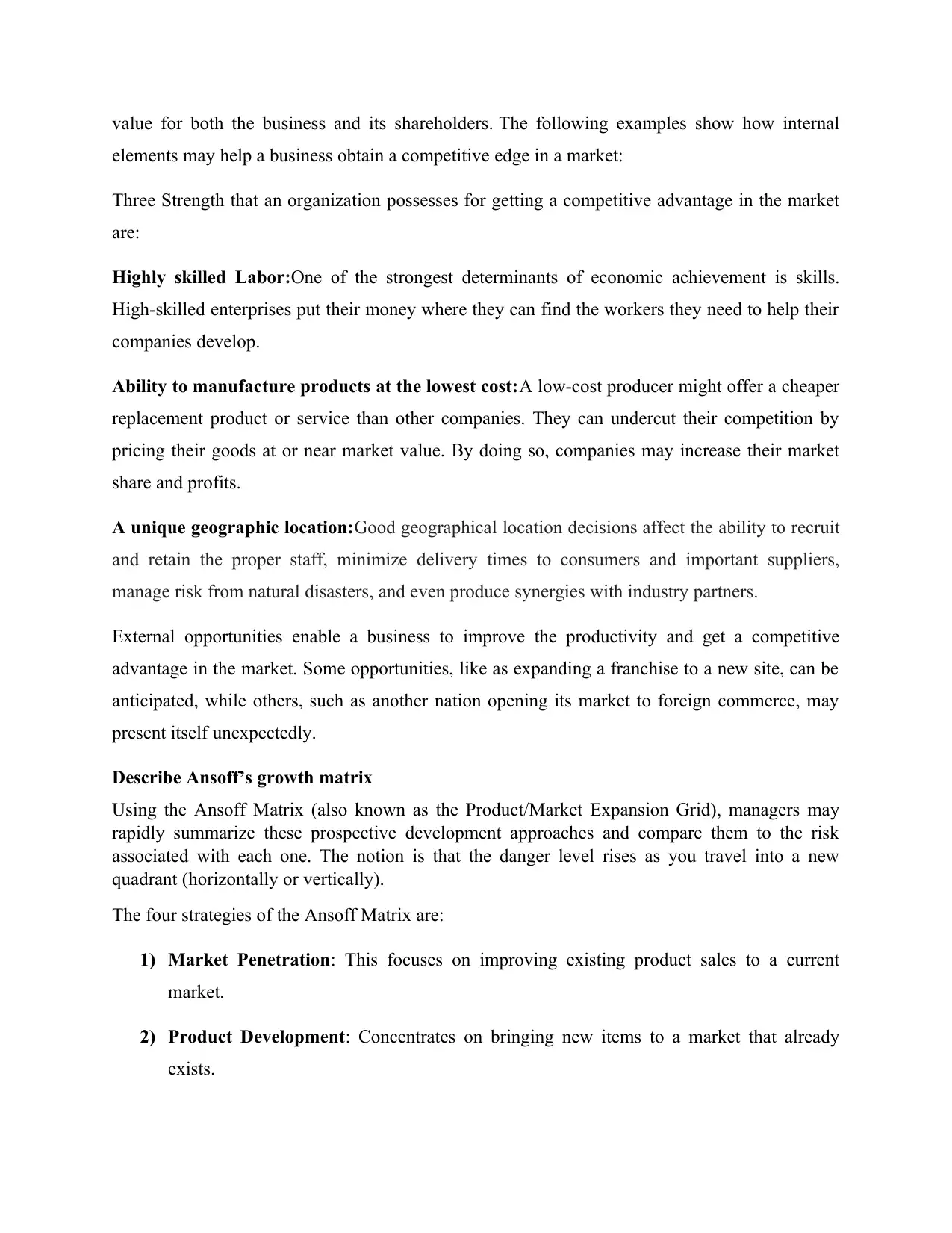
value for both the business and its shareholders. The following examples show how internal
elements may help a business obtain a competitive edge in a market:
Three Strength that an organization possesses for getting a competitive advantage in the market
are:
Highly skilled Labor:One of the strongest determinants of economic achievement is skills.
High-skilled enterprises put their money where they can find the workers they need to help their
companies develop.
Ability to manufacture products at the lowest cost:A low-cost producer might offer a cheaper
replacement product or service than other companies. They can undercut their competition by
pricing their goods at or near market value. By doing so, companies may increase their market
share and profits.
A unique geographic location:Good geographical location decisions affect the ability to recruit
and retain the proper staff, minimize delivery times to consumers and important suppliers,
manage risk from natural disasters, and even produce synergies with industry partners.
External opportunities enable a business to improve the productivity and get a competitive
advantage in the market. Some opportunities, like as expanding a franchise to a new site, can be
anticipated, while others, such as another nation opening its market to foreign commerce, may
present itself unexpectedly.
Describe Ansoff’s growth matrix
Using the Ansoff Matrix (also known as the Product/Market Expansion Grid), managers may
rapidly summarize these prospective development approaches and compare them to the risk
associated with each one. The notion is that the danger level rises as you travel into a new
quadrant (horizontally or vertically).
The four strategies of the Ansoff Matrix are:
1) Market Penetration: This focuses on improving existing product sales to a current
market.
2) Product Development: Concentrates on bringing new items to a market that already
exists.
elements may help a business obtain a competitive edge in a market:
Three Strength that an organization possesses for getting a competitive advantage in the market
are:
Highly skilled Labor:One of the strongest determinants of economic achievement is skills.
High-skilled enterprises put their money where they can find the workers they need to help their
companies develop.
Ability to manufacture products at the lowest cost:A low-cost producer might offer a cheaper
replacement product or service than other companies. They can undercut their competition by
pricing their goods at or near market value. By doing so, companies may increase their market
share and profits.
A unique geographic location:Good geographical location decisions affect the ability to recruit
and retain the proper staff, minimize delivery times to consumers and important suppliers,
manage risk from natural disasters, and even produce synergies with industry partners.
External opportunities enable a business to improve the productivity and get a competitive
advantage in the market. Some opportunities, like as expanding a franchise to a new site, can be
anticipated, while others, such as another nation opening its market to foreign commerce, may
present itself unexpectedly.
Describe Ansoff’s growth matrix
Using the Ansoff Matrix (also known as the Product/Market Expansion Grid), managers may
rapidly summarize these prospective development approaches and compare them to the risk
associated with each one. The notion is that the danger level rises as you travel into a new
quadrant (horizontally or vertically).
The four strategies of the Ansoff Matrix are:
1) Market Penetration: This focuses on improving existing product sales to a current
market.
2) Product Development: Concentrates on bringing new items to a market that already
exists.
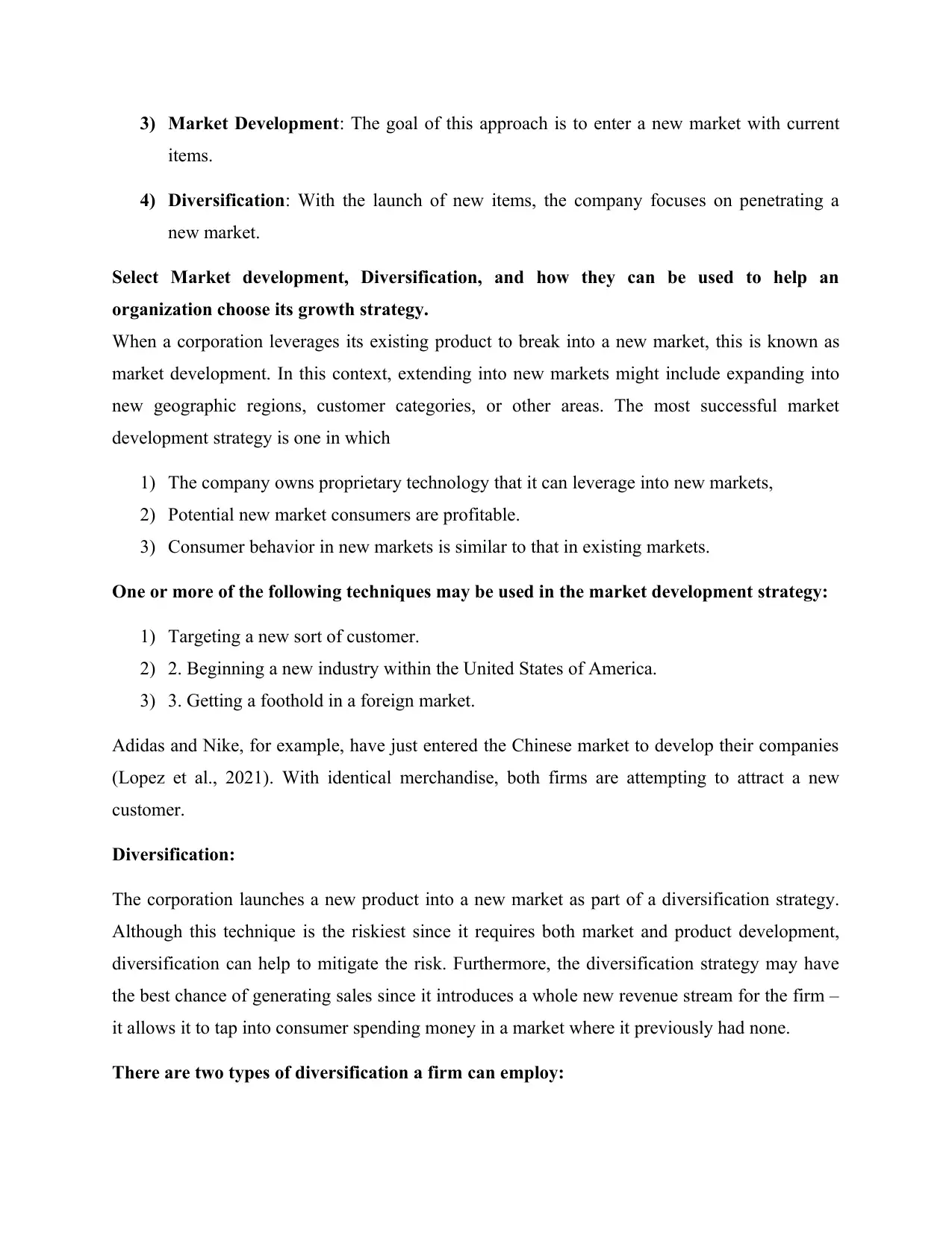
3) Market Development: The goal of this approach is to enter a new market with current
items.
4) Diversification: With the launch of new items, the company focuses on penetrating a
new market.
Select Market development, Diversification, and how they can be used to help an
organization choose its growth strategy.
When a corporation leverages its existing product to break into a new market, this is known as
market development. In this context, extending into new markets might include expanding into
new geographic regions, customer categories, or other areas. The most successful market
development strategy is one in which
1) The company owns proprietary technology that it can leverage into new markets,
2) Potential new market consumers are profitable.
3) Consumer behavior in new markets is similar to that in existing markets.
One or more of the following techniques may be used in the market development strategy:
1) Targeting a new sort of customer.
2) 2. Beginning a new industry within the United States of America.
3) 3. Getting a foothold in a foreign market.
Adidas and Nike, for example, have just entered the Chinese market to develop their companies
(Lopez et al., 2021). With identical merchandise, both firms are attempting to attract a new
customer.
Diversification:
The corporation launches a new product into a new market as part of a diversification strategy.
Although this technique is the riskiest since it requires both market and product development,
diversification can help to mitigate the risk. Furthermore, the diversification strategy may have
the best chance of generating sales since it introduces a whole new revenue stream for the firm –
it allows it to tap into consumer spending money in a market where it previously had none.
There are two types of diversification a firm can employ:
items.
4) Diversification: With the launch of new items, the company focuses on penetrating a
new market.
Select Market development, Diversification, and how they can be used to help an
organization choose its growth strategy.
When a corporation leverages its existing product to break into a new market, this is known as
market development. In this context, extending into new markets might include expanding into
new geographic regions, customer categories, or other areas. The most successful market
development strategy is one in which
1) The company owns proprietary technology that it can leverage into new markets,
2) Potential new market consumers are profitable.
3) Consumer behavior in new markets is similar to that in existing markets.
One or more of the following techniques may be used in the market development strategy:
1) Targeting a new sort of customer.
2) 2. Beginning a new industry within the United States of America.
3) 3. Getting a foothold in a foreign market.
Adidas and Nike, for example, have just entered the Chinese market to develop their companies
(Lopez et al., 2021). With identical merchandise, both firms are attempting to attract a new
customer.
Diversification:
The corporation launches a new product into a new market as part of a diversification strategy.
Although this technique is the riskiest since it requires both market and product development,
diversification can help to mitigate the risk. Furthermore, the diversification strategy may have
the best chance of generating sales since it introduces a whole new revenue stream for the firm –
it allows it to tap into consumer spending money in a market where it previously had none.
There are two types of diversification a firm can employ:
⊘ This is a preview!⊘
Do you want full access?
Subscribe today to unlock all pages.

Trusted by 1+ million students worldwide
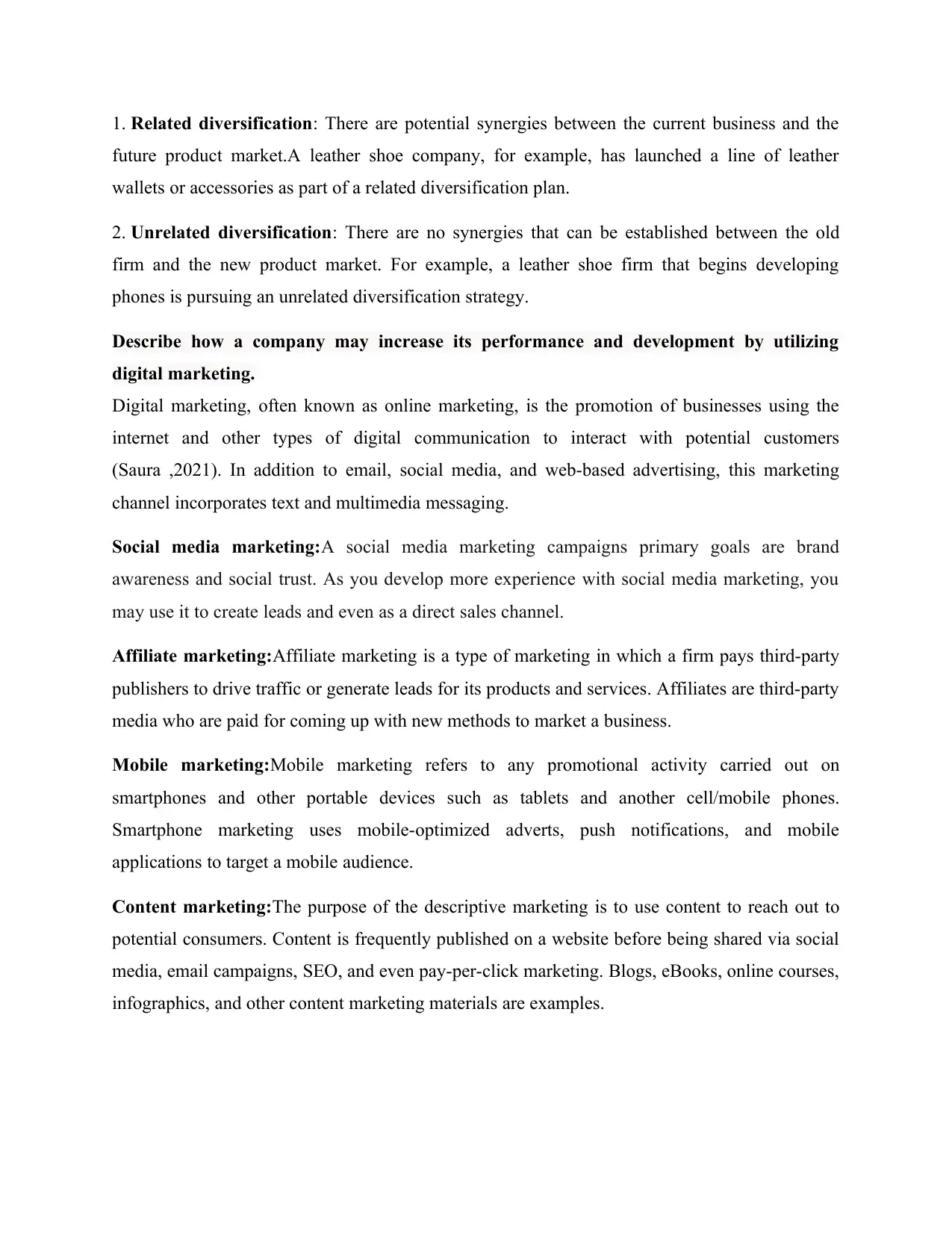
1. Related diversification: There are potential synergies between the current business and the
future product market.A leather shoe company, for example, has launched a line of leather
wallets or accessories as part of a related diversification plan.
2. Unrelated diversification: There are no synergies that can be established between the old
firm and the new product market. For example, a leather shoe firm that begins developing
phones is pursuing an unrelated diversification strategy.
Describe how a company may increase its performance and development by utilizing
digital marketing.
Digital marketing, often known as online marketing, is the promotion of businesses using the
internet and other types of digital communication to interact with potential customers
(Saura ,2021). In addition to email, social media, and web-based advertising, this marketing
channel incorporates text and multimedia messaging.
Social media marketing:A social media marketing campaigns primary goals are brand
awareness and social trust. As you develop more experience with social media marketing, you
may use it to create leads and even as a direct sales channel.
Affiliate marketing:Affiliate marketing is a type of marketing in which a firm pays third-party
publishers to drive traffic or generate leads for its products and services. Affiliates are third-party
media who are paid for coming up with new methods to market a business.
Mobile marketing:Mobile marketing refers to any promotional activity carried out on
smartphones and other portable devices such as tablets and another cell/mobile phones.
Smartphone marketing uses mobile-optimized adverts, push notifications, and mobile
applications to target a mobile audience.
Content marketing:The purpose of the descriptive marketing is to use content to reach out to
potential consumers. Content is frequently published on a website before being shared via social
media, email campaigns, SEO, and even pay-per-click marketing. Blogs, eBooks, online courses,
infographics, and other content marketing materials are examples.
future product market.A leather shoe company, for example, has launched a line of leather
wallets or accessories as part of a related diversification plan.
2. Unrelated diversification: There are no synergies that can be established between the old
firm and the new product market. For example, a leather shoe firm that begins developing
phones is pursuing an unrelated diversification strategy.
Describe how a company may increase its performance and development by utilizing
digital marketing.
Digital marketing, often known as online marketing, is the promotion of businesses using the
internet and other types of digital communication to interact with potential customers
(Saura ,2021). In addition to email, social media, and web-based advertising, this marketing
channel incorporates text and multimedia messaging.
Social media marketing:A social media marketing campaigns primary goals are brand
awareness and social trust. As you develop more experience with social media marketing, you
may use it to create leads and even as a direct sales channel.
Affiliate marketing:Affiliate marketing is a type of marketing in which a firm pays third-party
publishers to drive traffic or generate leads for its products and services. Affiliates are third-party
media who are paid for coming up with new methods to market a business.
Mobile marketing:Mobile marketing refers to any promotional activity carried out on
smartphones and other portable devices such as tablets and another cell/mobile phones.
Smartphone marketing uses mobile-optimized adverts, push notifications, and mobile
applications to target a mobile audience.
Content marketing:The purpose of the descriptive marketing is to use content to reach out to
potential consumers. Content is frequently published on a website before being shared via social
media, email campaigns, SEO, and even pay-per-click marketing. Blogs, eBooks, online courses,
infographics, and other content marketing materials are examples.
Paraphrase This Document
Need a fresh take? Get an instant paraphrase of this document with our AI Paraphraser
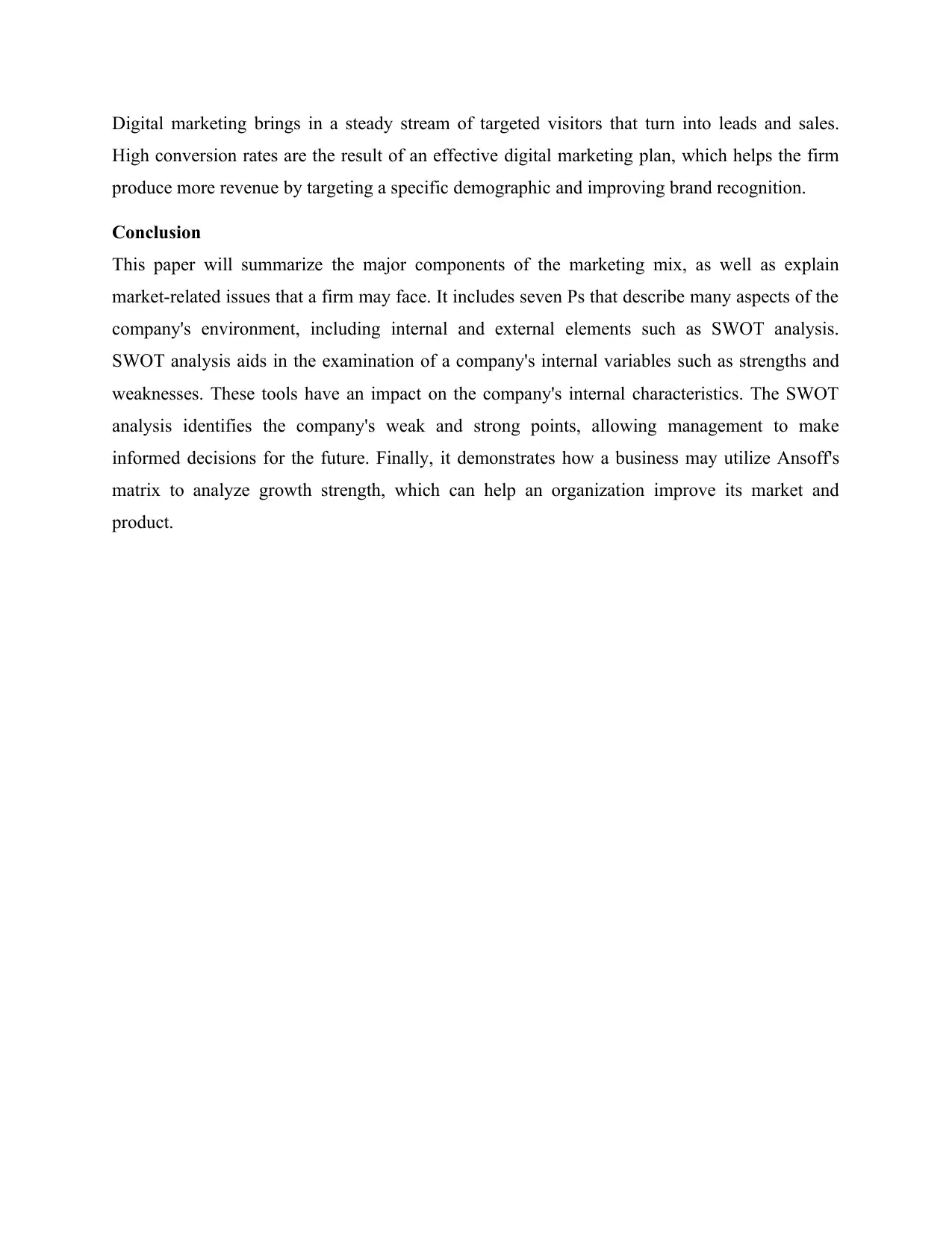
Digital marketing brings in a steady stream of targeted visitors that turn into leads and sales.
High conversion rates are the result of an effective digital marketing plan, which helps the firm
produce more revenue by targeting a specific demographic and improving brand recognition.
Conclusion
This paper will summarize the major components of the marketing mix, as well as explain
market-related issues that a firm may face. It includes seven Ps that describe many aspects of the
company's environment, including internal and external elements such as SWOT analysis.
SWOT analysis aids in the examination of a company's internal variables such as strengths and
weaknesses. These tools have an impact on the company's internal characteristics. The SWOT
analysis identifies the company's weak and strong points, allowing management to make
informed decisions for the future. Finally, it demonstrates how a business may utilize Ansoff's
matrix to analyze growth strength, which can help an organization improve its market and
product.
High conversion rates are the result of an effective digital marketing plan, which helps the firm
produce more revenue by targeting a specific demographic and improving brand recognition.
Conclusion
This paper will summarize the major components of the marketing mix, as well as explain
market-related issues that a firm may face. It includes seven Ps that describe many aspects of the
company's environment, including internal and external elements such as SWOT analysis.
SWOT analysis aids in the examination of a company's internal variables such as strengths and
weaknesses. These tools have an impact on the company's internal characteristics. The SWOT
analysis identifies the company's weak and strong points, allowing management to make
informed decisions for the future. Finally, it demonstrates how a business may utilize Ansoff's
matrix to analyze growth strength, which can help an organization improve its market and
product.
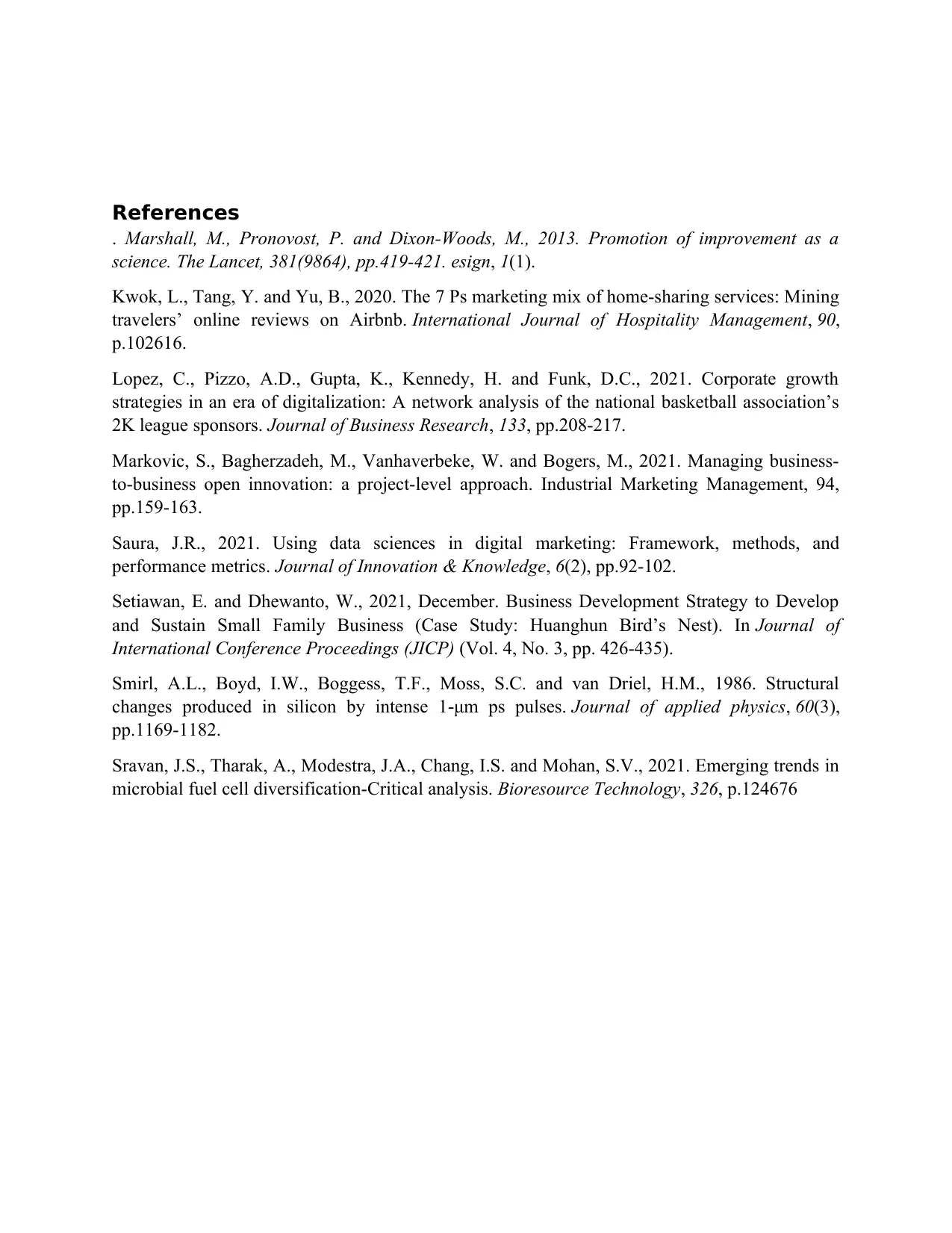
References
. Marshall, M., Pronovost, P. and Dixon-Woods, M., 2013. Promotion of improvement as a
science. The Lancet, 381(9864), pp.419-421. esign, 1(1).
Kwok, L., Tang, Y. and Yu, B., 2020. The 7 Ps marketing mix of home-sharing services: Mining
travelers’ online reviews on Airbnb. International Journal of Hospitality Management, 90,
p.102616.
Lopez, C., Pizzo, A.D., Gupta, K., Kennedy, H. and Funk, D.C., 2021. Corporate growth
strategies in an era of digitalization: A network analysis of the national basketball association’s
2K league sponsors. Journal of Business Research, 133, pp.208-217.
Markovic, S., Bagherzadeh, M., Vanhaverbeke, W. and Bogers, M., 2021. Managing business-
to-business open innovation: a project-level approach. Industrial Marketing Management, 94,
pp.159-163.
Saura, J.R., 2021. Using data sciences in digital marketing: Framework, methods, and
performance metrics. Journal of Innovation & Knowledge, 6(2), pp.92-102.
Setiawan, E. and Dhewanto, W., 2021, December. Business Development Strategy to Develop
and Sustain Small Family Business (Case Study: Huanghun Bird’s Nest). In Journal of
International Conference Proceedings (JICP) (Vol. 4, No. 3, pp. 426-435).
Smirl, A.L., Boyd, I.W., Boggess, T.F., Moss, S.C. and van Driel, H.M., 1986. Structural
changes produced in silicon by intense 1 μm ps pulses.‐ Journal of applied physics, 60(3),
pp.1169-1182.
Sravan, J.S., Tharak, A., Modestra, J.A., Chang, I.S. and Mohan, S.V., 2021. Emerging trends in
microbial fuel cell diversification-Critical analysis. Bioresource Technology, 326, p.124676
. Marshall, M., Pronovost, P. and Dixon-Woods, M., 2013. Promotion of improvement as a
science. The Lancet, 381(9864), pp.419-421. esign, 1(1).
Kwok, L., Tang, Y. and Yu, B., 2020. The 7 Ps marketing mix of home-sharing services: Mining
travelers’ online reviews on Airbnb. International Journal of Hospitality Management, 90,
p.102616.
Lopez, C., Pizzo, A.D., Gupta, K., Kennedy, H. and Funk, D.C., 2021. Corporate growth
strategies in an era of digitalization: A network analysis of the national basketball association’s
2K league sponsors. Journal of Business Research, 133, pp.208-217.
Markovic, S., Bagherzadeh, M., Vanhaverbeke, W. and Bogers, M., 2021. Managing business-
to-business open innovation: a project-level approach. Industrial Marketing Management, 94,
pp.159-163.
Saura, J.R., 2021. Using data sciences in digital marketing: Framework, methods, and
performance metrics. Journal of Innovation & Knowledge, 6(2), pp.92-102.
Setiawan, E. and Dhewanto, W., 2021, December. Business Development Strategy to Develop
and Sustain Small Family Business (Case Study: Huanghun Bird’s Nest). In Journal of
International Conference Proceedings (JICP) (Vol. 4, No. 3, pp. 426-435).
Smirl, A.L., Boyd, I.W., Boggess, T.F., Moss, S.C. and van Driel, H.M., 1986. Structural
changes produced in silicon by intense 1 μm ps pulses.‐ Journal of applied physics, 60(3),
pp.1169-1182.
Sravan, J.S., Tharak, A., Modestra, J.A., Chang, I.S. and Mohan, S.V., 2021. Emerging trends in
microbial fuel cell diversification-Critical analysis. Bioresource Technology, 326, p.124676
⊘ This is a preview!⊘
Do you want full access?
Subscribe today to unlock all pages.

Trusted by 1+ million students worldwide
1 out of 9
Related Documents
Your All-in-One AI-Powered Toolkit for Academic Success.
+13062052269
info@desklib.com
Available 24*7 on WhatsApp / Email
![[object Object]](/_next/static/media/star-bottom.7253800d.svg)
Unlock your academic potential
Copyright © 2020–2025 A2Z Services. All Rights Reserved. Developed and managed by ZUCOL.





